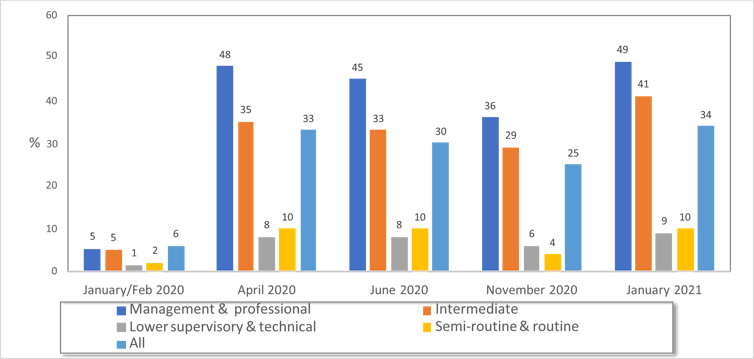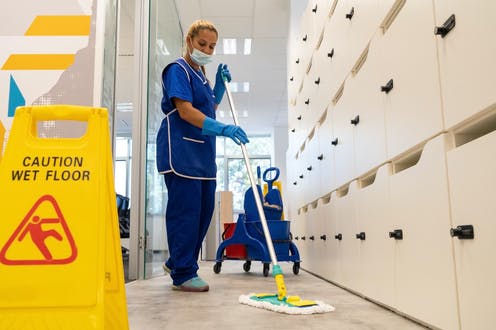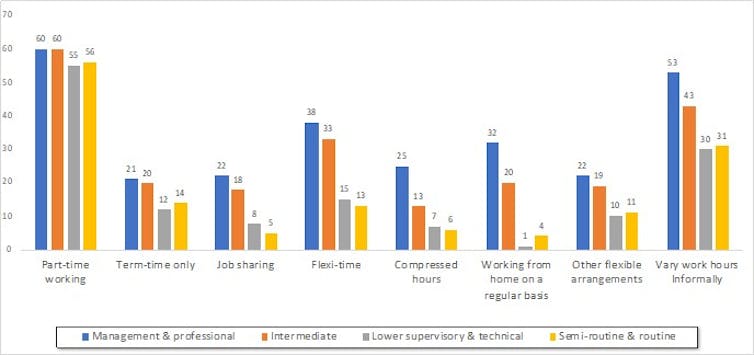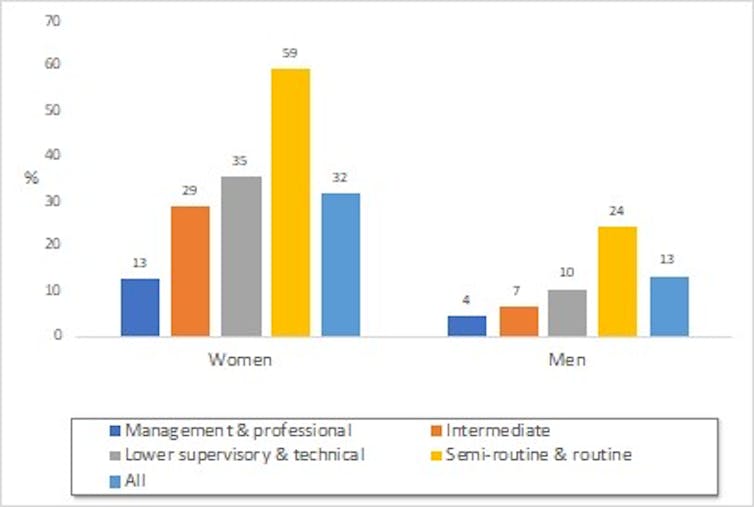Since the arrival of the pandemic, media accounts about the new world of work have painted a curiously uniform picture of the jobs that people across the UK do. Chief among them was the idea that everyone was all suddenly compelled to work fully from home, with each working day newly shaped by endless online calls and muted-microphone hitches, all brightened by the unruly entry of pets and small children into serious meetings.
It’s an idea that will be given more credence now that Sage, the government’s science advisory group, has suggested that working from home is “likely to be needed beyond the end of the current road map process” out of lockdown, namely for COVID-safety purposes. But though this may be the reality for some office employees, this popular framing of the impact of COVID-19 on how and where we work is a firmly class-based story.
As the effects of the pandemic became more apparent in the UK, class inequalities quickly shaped employee experiences, with some workers better protected from the negative impacts of COVID-19 but many more severely disadvantaged, fearing for their health, job security and income.
The importance of class for the analysis of pandemic-impacted working lives has been under-examined and too rarely discussed. In our research project with the UK Women’s Budget Group, we looked at working lives in the face of the extraordinary and shifting burdens brought on by the pandemic. We focused on how working-class women fared compared with other groups of employees. Our findings show deep inequalities in how COVID-19 affected how we work.
Very few working-class people worked from home
Focusing solely on the disadvantages, delights and future potential of working from home neglects the fact that most of the UK’s workforce rarely or never worked from home after the pandemic hit. Yet the media put emphasis on these circumstances, prioritising the experiences of a select group of workers while disguising real class inequity in both who could work from their homes and home-working conditions.
Before the pandemic, only 6% of women workers (and 4% of men) had “always” been working from home. After the first national lockdown, those figures jumped sharply to a third of the employed. Even then, home-working was a strongly classed phenomenon. Around a half of workers in managerial and professional jobs reported that they were working from home all of the time in April 2020 (with an additional 24% saying they sometimes or often did so).
The figures for working-class employees, however, tell a very different story. Only 10% of working-class women in semi-routine jobs (such as care-workers, retail assistants, hospital porters) or routine jobs (cleaners, waiting staff, bus drivers, bar staff, sewing machinists, according to the National Statistics Socio-economic Classification) were always working from home (only 10% more reported doing it sometimes or often).

Figure 1: Which women were always working from home? (Employed women aged 18-65) Clare Lyonette/Tracey Warren, Author provided
A positive experience for everyone?
While many of those who had to work fully from home already had a suitable home office set-up, far more had to make do with working at cramped tables or from sofas and beds. There were also deep class disparities in who had adequate computing facilities with reliable and fast broadband and printing and office supplies. As the summer months came to an end, inequalities in home-working conditions were intensified by stark variations in the workers’ abilities to afford to heat home work spaces over an extended period.
Working from home is only one of a range of flexible working arrangements available to many workers. Some workers were permitted more flexible working, including fitting work around intensified caring or home-schooling responsibilities, but access to good quality arrangements during the pandemic was, as it had been before, firmly classed. In June, 38% of managerial and professional women could work flexibly and 53% vary their work hours informally, compared with only 13% and 31% of working-class women.
Figure 2. Which women had access to flexible working arrangements in their workplace?(Employed women aged 18-65. June 2020) Clare Lyonette/Tracey Warren, Author provided
Class inequalities persisted in workers’ wages and household earnings, with working-class women faring the most poorly, taking home the lowest weekly wages in our employed sample. Compared with senior workers, far fewer of the working class were able to make savings from their income, building up no financial safety nets. As 2020 came to a close, a growing large minority of working-class women said that they were in difficulties or just about getting by financially.
Figure 3. Which workers had low weekly earnings? Clare Lyonette/Tracey Warren, Author provided
The idea of working in frontline and essential jobs while managing the pressures of living, working and caring through a global pandemic and struggling to make ends meet doesn’t sound much like the accounts we’re used to hearing about the pandemic’s impact on working lives. But it speaks to the lives of far more in the working population than debates that focus on the experiences of a minority and relatively privileged group. Without widespread recognition and urgent government support, the traditional working-class backbone of the workforce will be stretched to the limit, with longer-term implications for the rest of society.



 The Beauty Beneath the Expressway: A Journey from Self to Service
The Beauty Beneath the Expressway: A Journey from Self to Service  Debate over H-1B visas shines spotlight on US tech worker shortages
Debate over H-1B visas shines spotlight on US tech worker shortages  Youth are charting new freshwater futures by learning from the water on the water
Youth are charting new freshwater futures by learning from the water on the water  The ghost of Robodebt – Federal Court rules billions of dollars in welfare debts must be recalculated
The ghost of Robodebt – Federal Court rules billions of dollars in welfare debts must be recalculated  The American mass exodus to Canada amid Trump 2.0 has yet to materialize
The American mass exodus to Canada amid Trump 2.0 has yet to materialize  Yes, government influences wages – but not just in the way you might think
Yes, government influences wages – but not just in the way you might think  How to support someone who is grieving: five research-backed strategies
How to support someone who is grieving: five research-backed strategies  Can your cat recognise you by scent? New study shows it’s likely
Can your cat recognise you by scent? New study shows it’s likely  Why financial hardship is more likely if you’re disabled or sick
Why financial hardship is more likely if you’re disabled or sick  Glastonbury is as popular than ever, but complaints about the lineup reveal its generational challenge
Glastonbury is as popular than ever, but complaints about the lineup reveal its generational challenge  Britain has almost 1 million young people not in work or education – here’s what evidence shows can change that
Britain has almost 1 million young people not in work or education – here’s what evidence shows can change that  Columbia Student Mahmoud Khalil Fights Arrest as Deportation Case Moves to New Jersey
Columbia Student Mahmoud Khalil Fights Arrest as Deportation Case Moves to New Jersey  Why have so few atrocities ever been recognised as genocide?
Why have so few atrocities ever been recognised as genocide? 


































